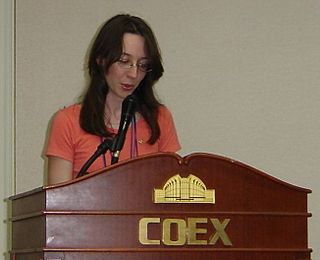Minnesota Public Radio (MPR), is a public radio network for the state of Minnesota. With its three services, News & Information, YourClassical MPR and The Current, MPR operates a 46-station regional radio network in the upper Midwest.
A news presenter – also known as a newsreader, newscaster, anchorman or anchorwoman, news anchor or simply an anchor – is a person who presents news during a news program on TV, radio or the Internet. They may also be a working journalist, assisting in the collection of news material and may, in addition, provide commentary during the program. News presenters most often work from a television studio or radio studio, but may also present the news from remote locations in the field related to a particular major news event.

The media of Canada is highly autonomous, uncensored, diverse, and very regionalized. Canada has a well-developed media sector, but its cultural output—particularly in English films, television shows, and magazines—is often overshadowed by imports from the United States. As a result, the preservation of a distinctly Canadian culture is supported by federal government programs, laws, and institutions such as the Canadian Broadcasting Corporation (CBC), the National Film Board of Canada (NFB), and the Canadian Radio-television and Telecommunications Commission (CRTC).

The Asian American Journalists Association (AAJA) is a 501(c)3 nonprofit educational and professional organization based in San Francisco, California with more than 1,500 members and 21 chapters across the United States and Asia. The current president is Washington Post reporter Nicole Dungca. The executive director is Naomi Tacuyan Underwood.

Public Radio International (PRI) was an American public radio organization. Headquartered in Minneapolis, Minnesota, PRI provided programming to over 850 public radio stations in the United States.

Citizen journalism, also known as collaborative media, participatory journalism, democratic journalism, guerrilla journalism or street journalism, is based upon public citizens "playing an active role in the process of collecting, reporting, analyzing, and disseminating news and information." Similarly, Courtney C. Radsch defines citizen journalism "as an alternative and activist form of news gathering and reporting that functions outside mainstream media institutions, often as a response to shortcomings in the professional journalistic field, that uses similar journalistic practices but is driven by different objectives and ideals and relies on alternative sources of legitimacy than traditional or mainstream journalism". Jay Rosen offers a simpler definition: "When the people formerly known as the audience employ the press tools they have in their possession to inform one another." The underlying principle of citizen journalism is that ordinary people, not professional journalists, can be the main creators and distributors of news. Citizen journalism should not be confused with community journalism or civic journalism, both of which are practiced by professional journalists; collaborative journalism, which is the practice of professional and non-professional journalists working together; and social journalism, which denotes a digital publication with a hybrid of professional and non-professional journalism.
The Canadian Association of Journalists is an independent, not-for-profit organization that offers advocacy and professional development to journalists across Canada. The CAJ was created to promote excellence in journalism and to encourage investigative journalism in Canada. The CAJ presents annual investigative journalism awards, including the McGillivray Award and the Charles Bury Award.
American Public Media (APM) is an American company that produces and distributes public radio programs in the United States, the second largest company of its type after NPR. Its non-profit parent, American Public Media Group, also owns and operates radio stations in Minnesota and California. Its station brands include Minnesota Public Radio and Southern California Public Radio. Based in St. Paul, Minnesota, APM is best known for distribution of the national financial news program Marketplace.

News broadcasting is the medium of broadcasting various news events and other information via television, radio, or the internet in the field of broadcast journalism. The content is usually either produced locally in a radio studio or television studio newsroom, or by a broadcast network. It may include material such as sports coverage, weather forecasts, traffic reports, political commentary, expert opinions, editorial content, and other material that the broadcaster feels is relevant to their audience. An individual news program is typically reported in a series of individual stories that are presented by one or more anchors. A frequent inclusion is live or recorded interviews by field reporters.

Broadcast journalism is the field of news and journals which are broadcast by electronic methods instead of the older methods, such as printed newspapers and posters. It works on radio, television and the World Wide Web. Such media disperse pictures, visual text and sounds.

The World is a US public radio news magazine with an emphasis on international news. The program originated partly in response to declining coverage of international news by US commercial media. It is co-produced by WGBH and the Public Radio Exchange (PRX) of the United States.

Citizen media is content produced by private citizens who are not professional journalists. Citizen journalism, participatory media and democratic media are related principles.

Connecticut Public Television (CPTV) is the PBS member network for the U.S. state of Connecticut. It is owned by Connecticut Public Broadcasting, a community-based non-profit organization that holds the licenses for all PBS member stations licensed in the state, and also owns the state's NPR member, Connecticut Public Radio (WNPR). Together, the television and radio stations make up the Connecticut Public Broadcasting Network (CPBN). CPBN is the state's only locally owned media organization producing TV, radio, print and Internet content for distribution across the state. As of 2019, Mark Contreras was announced as the new President / CEO. The organizational structure of CPTV also includes a Board of Trustees. The network co-produced the long-running children's television series, Barney & Friends until the show were transferred to WNET.

Mass media are the means through which information is transmitted to a large audience. This includes newspapers, television, radio, and more recently the Internet. Organizations that provide news through mass media in the United States are collectively known as the news media in the United States.
Latino USA is a nationally syndicated public radio program and podcast produced by The Futuro Media Group and distributed nationwide by the Public Radio Exchange (PRX), after 27 years of being distributed by NPR. The program is anchored by Maria Hinojosa.

News is information about current events. This may be provided through many different media: word of mouth, printing, postal systems, broadcasting, electronic communication, or through the testimony of observers and witnesses to events. News is sometimes called "hard news" to differentiate it from soft media.
The mass media in Bangladesh refers to the print, broadcast and online mass media available in Bangladesh. The Constitution guarantees press freedom and freedom of expression within "reasonable restriction", though some media outlets have been harassed. The Bangladeshi media's rank is dropped to 146 in 2018 from its position of 144 in 2016 out of total 180 countries on the Reporters Without Borders Press Freedom Index, with 1st being most free.
Media development involves capacity building for institutions or individuals related to freedom of expression, pluralism and diversity of media, as well as transparency of media ownership. Media development plays a role in democracy and effective democratic discourse through supporting free and independent media.

Canadian online media is content aimed at a Canadian audience through the medium of the Internet. Presently, online media can be accessed by computers, smart-phones, gaming consoles, Smart TVs, MP3 players, and tablets. The characteristics of Canadian online media are strongly shaped by the Canadian communications industry, even though their statistics and findings are more often than not associated with American research. Large media companies are increasingly on the move to start up online platforms for news and television content. The exponential growth of Canadians' dependency on online content for entertainment and information has been evident in the recent decades. However, it has proven slow for Canadian online media to catch up with the constant increase of American online media. Regardless of medium, entertainment and information hubs are not solely focusing on satisfying the audience they have, but are also heavily expanding their reach to new global audiences.
Joseph Rosendo is an American travel journalist, broadcaster, television personality and public speaker. Since 2007 he has been the executive producer, host, director and writer of the American Public Television series Joseph Rosendo’s Travelscope which has aired on PBS and Public Television Stations in the United States and Canada with 117 episodes in distribution. Season 10 was released in the spring of 2018 and Season 11 followed in August, 2019.









